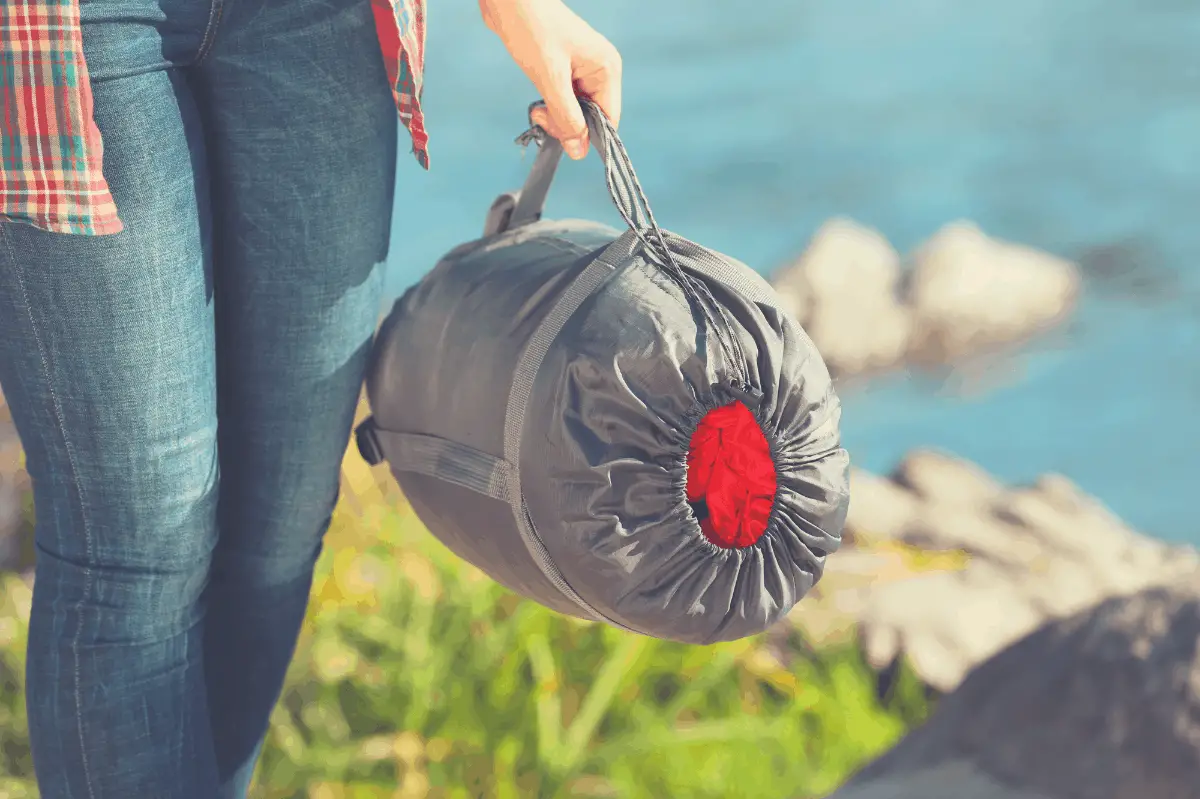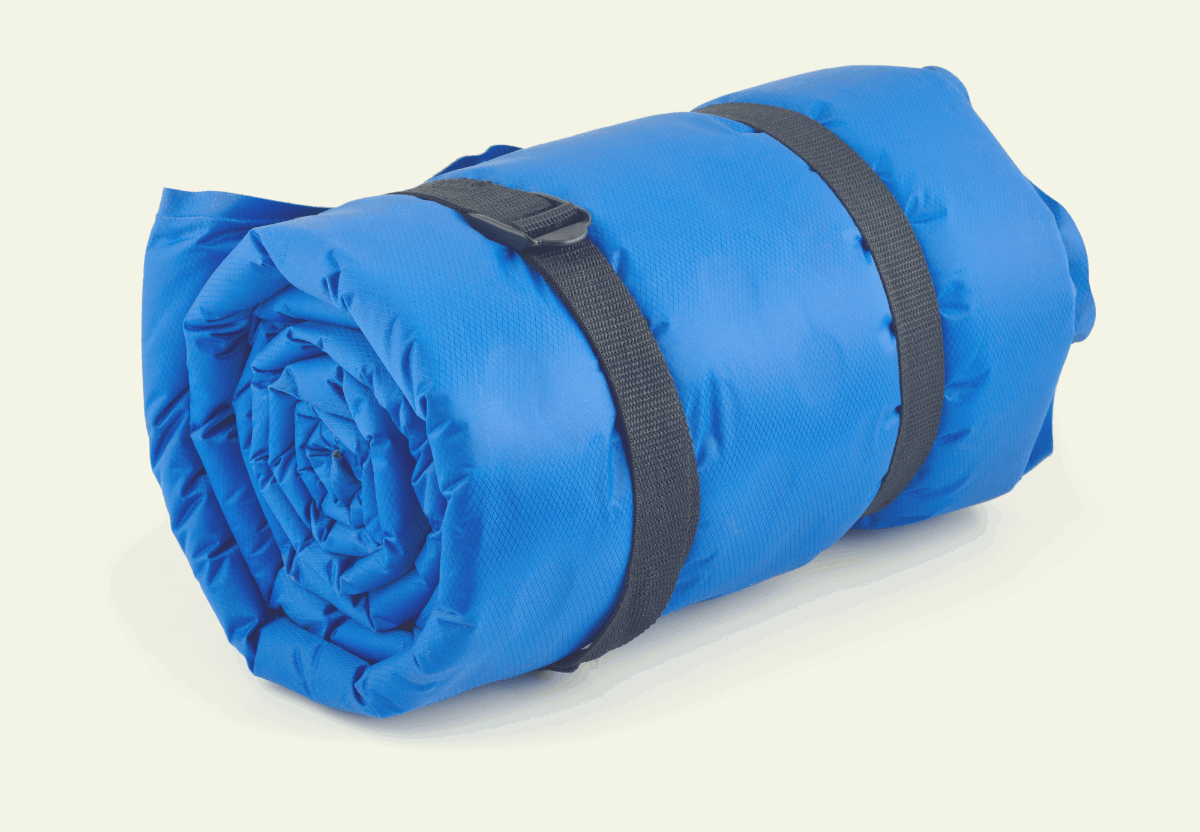Are you excited about your first camping or backpacking trip? Learning to fold a sleeping bag is one of the skills required to keep you mobile during the day and comfortable at night especially in not so favorable climates.
Unfortunately, many beginners struggle with the process and end up wasting a lot of time or with a partially rolled-up sleeping bag that is too cumbersome to carry. This can put a dent in the whole outdoor experience.
How do you Roll Up A Sleeping Bag?
Rolling up a sleeping bag may be less complicated than it sounds as long as you follow the right instructions and get the necessary materials to make it a success. Here’s a simple step by step tutorial for beginners to fold their outdoor sleeping bags successfully.
1. Gather The Supplies
The folding process requires a few supplies that may be readily available at home so, there’s no need to panic. These essentials include:
- Sleeping bag
- Straps long enough to wrap around the rolled-up bag (most sleeping bags ship with straps so this may be unnecessary).
- Duct tape (Your foot or any heavy object can be a suitable alternative)
2. Spread The Sleeping Bag
It is time to spread the sleeping bag on a clean and dry floor. Run your hands down every inch of the bag’s surface to make sure it is completely flat. Keep in mind that the flatter the sleeping bag’s surface, the higher the chances of rolling it up with ease and ending up with the most portable size.
3. Fold it in Half
Whether the sleeping bag comes in a rectangular, semi-rectangular, or mummy shape, fold it evenly in half can be critical. After folding, run your hands down the length and breadth of the bag to eliminate any air bubbles that may have invaded the bag during the folding process.
Since the opening of the bag at the top is where any excess air bubbles can escape, the trick is to flatten the bag from bottom to the top.
Finally, make sure the two long sides of the sleeping bag are properly aligned to make the folding-up process as smooth as possible.
4. Time To Roll-Up The Sleeping Bag
The roll-up process is where all the magic happens and the instructions are as follows:
- Place any heavy object such as a large duct tape at the top part of the sleeping bag to keep it steady while rolling it up.
- Begin at the bottom or foot section of the bag and roll it up to the top to push out any air bubbles.
- Keep the bag as small and tight as possible by placing the knees on the rolled-up section as you continue to roll.
- If the top or head section begins to unravel during rolling, adjust the position of the heavy object to keep it steady.
- Remember, the thicker the size of the bag, the higher the amount of movement possible during rolling up.
- Try to roll up the bag to the smallest size by pushing out optimum amounts of air at every step.
- Wrap the straps attached to the bag or (bought separately) around the bag to ensure the rolled-up bag stays small and does not unravel.
- Put the folded sleeping bag into a backpack or sack for easy transportation.
What is A Sleeping Bag?
A sleeping bag is a lightweight quilt fabric bedding typically designed to be covered with a zipper that serves as a sleeping surface for outdoor environments. It features built-in insulation to keep the sleeper warm even during the coldest temperatures at night.
Types of Sleeping Bags
Sleeping bags come in 3 main types based on their temperature ratings. The time of the year you’re going camping as well as individual preferences can determine the right type to choose.
Being aware of the differences is essential because nothing can be worse than rolling up the wrong sleeping bag for a camping or hiking trip. The probability of getting good sleep could be next to zero.
Summer Season: These are bags with a temperature rating of 30 degrees Fahrenheit and higher.
Three-Season: The temperature rating for 3-season sleeping bags range between 15-30 degrees Fahrenheit.
Winter Season: Winter season sleeping bags come with temperature ratings of 15 degrees Fahrenheit and lower.
How To Preserve the Lifespan of Rolled-Up Sleeping Bags
Folding a sleeping bag can be a great way to reduce its size for easy transportation among campers, hikers, road trippers, and other outdoor adventure enthusiasts. Unfortunately, the folding process may be a source of significant wear and tear on the bag’s physical condition which can decrease its lifespan.
Here are a few tried and tested techniques to preserve the physical condition of these bags during and after rolling it up.
1. Avoid Rolling it Up During Storage
It can be tempting to roll up a sleeping bag during storage especially among those with limited space at home. However, this can lead to a quicker deterioration of the bag’s built-in loft especially when rolled up tightly with little to no air.
Since the loft promotes insulation during (cold weathers) and air circulation (during the harshest summer nights), this can dwindle the powers of the sleeping bag quickly. Instead, leave the sleeping bag loosely in a closet or another storage area when not in use. Anytime you pick it up for an outdoor trip, maximum protection from the weather elements can be guaranteed.
2. Get A Stuff Sack

You need all the space you can get when backpacking internationally or on an outdoor trip not too far from home. This is where the optimum packing properties of stuff sacks can come in handy.
Integrated with several straps that can be maneuvered to make the size of the rolled-up sleeping bag even smaller, these sacks can be a real asset. The good news is that stuff sacks come in different sizes so you can even order one big enough to accommodate your sleeping bag and other personal effects.
3. Reverse Wind-Proof and Water-Proof Bags
Wind-proof and water-proof bags can be a nightmare to roll-up when traveling for an outdoor trip. This is because of the external layering of these bags which repel air during harsh outdoor conditions.
During folding-up of a bag when you need to keep out as much air as possible, the external layering can act in the opposite by trapping air in the bag. The only way out may be to turn such bags inside out before zipping them and following the standard roll-up process stipulated earlier.
4. Practice Good Bag Care
Good bag care can be vital to maximizing the lifespan and functionality of a sleeping bag. As previously stated, folding a sleeping bag tightly during storage is a big no-no. Instead, let it air out in the sun after each trip for a few hours to eliminate any odors and traces of bacteria.
Additionally, brush away unwanted particles such as mud, dust, leaves, molds, or mildew immediately upon arriving home even if the weather is not clear enough for outdoor drying. Make sure not to overexpose the sleeping bag to the sun’s rays as that can cause severe damage to the bag’s internal components.
5. Look Out For Leaking Down Feather Fabric
Down feather is one of the most popular fabrics in the sleeping bag industry. Even brand new models may show leaking pieces of down feathers and this may worsen over time as the sleeping bag begins to deteriorate physically.
Always pull any traces of down feather leakages back into the bag immediately because it is something to be expected.
When A Sleeping Bag Is Too Big For your Backpack
One of the common problems campers and outdoor enthusiasts face is the struggle to fit a sleeping bag into the complementary backpack the manufacturer ships with the bag. This issue may pop up during one of the following scenarios:
- The sleeping bag was not folded flat enough
- The manufacturer mismatched the size of the bag and shipped stuff sack
The only way out of this conundrum may be to refold the sleeping bag smaller by getting a pair of extra hands to roll up as tightly as possible while keeping out the maximum amount of air.
If the complementary stuff sack features synthetic material, buying a down fiber laze bag can be a great option too.
Do you Need to Learn How to Roll A Sleeping Bag?
Learning how to roll up a sleeping bag can come in handy if you fall into the following categories.
- Backpackers
- Campers
- Hikers
- The Homeless
- Road Trippers
Conclusion
Learning how to roll up a sleeping bag properly can be a great piece of skill that may come in handy in various situations. Some bags may be easier to compress than others due to their size, shape, and built-in material.
The good news is that we’ve shared the tips to fold up sleeping bags of any type successfully. If you own a 2- person or 3-person sleeping bag, it might be imperative to get additional help to make the process as smooth as possible.

